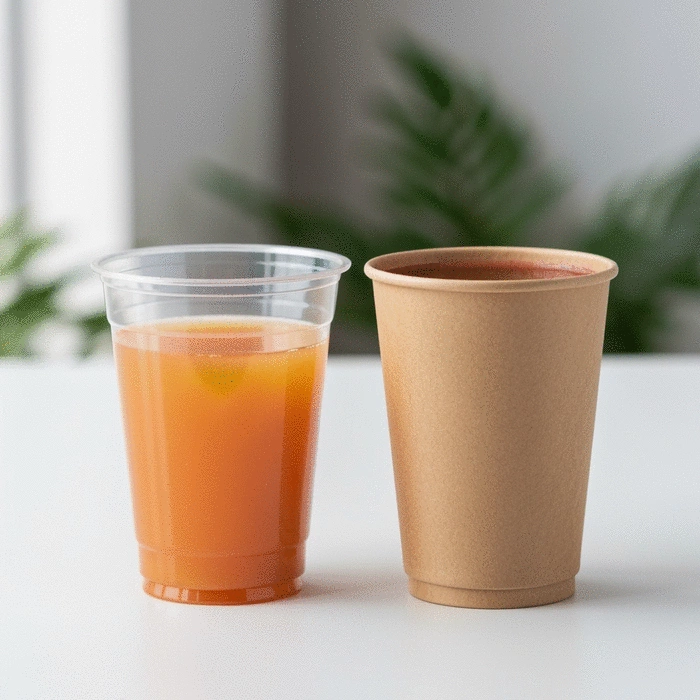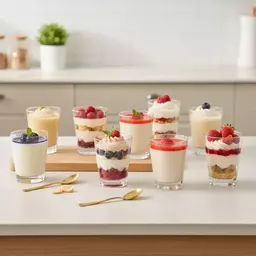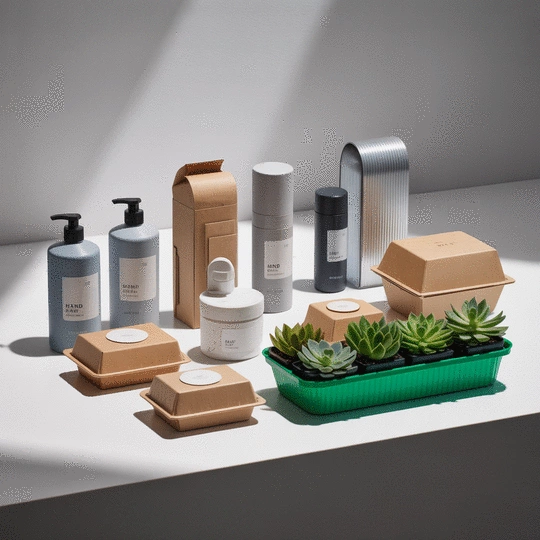Plastic vs. Paper Juice Cups

Posted on: 2025-10-13
By: Clara Voss
When it comes to disposable cups, understanding the differences between plastic and paper is essential for making informed choices that cater to your needs. With so many options available, how do you know which is right for your occasion? Here’s a concise breakdown of what you’ll learn.
What You Will Learn
- Plastic cups are primarily made from polypropylene and PET, making them lightweight and ideal for cold drinks.
- Paper cups feature a paperboard core with moisture-resistant coatings, suitable for hot beverages.
- Polypropylene cups are flexible and crack-resistant, while PET cups offer clarity that showcases colorful drinks.
- Evaluating strength and weight helps you choose the right cup for your specific needs—lightweight plastic or insulating paper.
- Consider environmental impact, budget, and beverage type when selecting between plastic and paper options.
- Proper disposal methods vary; plastic cups can often be recycled, while paper cups require checking local guidelines.
Plastic vs. Paper Cups: Key Comparisons
This visual highlights the fundamental differences and shared characteristics between plastic and paper cups, focusing on materials, properties, and disposal.
Plastic Cups
Ideal for cold drinks, known for durability and clarity.
Key Materials:
- Polypropylene (Flexible)
- Polyethylene Terephthalate (PET) (Clear)
Disposal:
Rinse and recycle where facilities exist, or general waste.
Paper Cups
Preferred for hot beverages, offers insulation and aesthetic appeal.
Key Materials:
- Paperboard (Strength)
- Plastic or Wax Coating (Moisture resistance)
Disposal:
Limited recyclability due to linings; check local guidelines.
Understanding the Essentials of Plastic and Paper Cups
When it comes to disposable cups, knowing the differences between plastic and paper is essential. They each serve unique purposes, catering to various needs across industries. From takeout orders to event gatherings, understanding the materials used can help in making informed choices. Let’s dive into the basics!
The Basics: What Are Plastic and Paper Cups Made Of?
Plastic cups are predominantly made from materials like polypropylene and polyethylene terephthalate (PET). These plastics are lightweight, durable, and suitable for cold drinks. On the flip side, paper cups typically consist of paperboard coated with a thin layer of plastic or wax for moisture resistance. This coating is crucial as it helps the paper hold liquids without leaking. Recent studies, such as the one published in PMC NCBI, highlight the importance of understanding these material compositions for environmental impact assessments.
- Plastic Cups: Polypropylene, Polyethylene Terephthalate
- Paper Cups: Paperboard with plastic or wax coating
Understanding these materials helps in selecting the right cup for different occasions. For instance, if you're hosting a summer picnic, you might lean toward plastic for its durability, while a coffee shop might prefer paper for its aesthetic appeal and ability to insulate hot drinks.
Popular Types of Plastic Cups: Polypropylene vs. Polyethylene Terephthalate
In the realm of plastic cups, two materials often stand out: polypropylene and polyethylene terephthalate (PET). Polypropylene cups are known for their flexibility and resistance to cracking, making them ideal for a variety of beverages, from soda to smoothies. Meanwhile, PET cups have a crystal-clear appearance, perfect for showcasing colorful drinks, which can be a great visual appeal for your customers.
- Polypropylene: Flexible, crack-resistant, great for various beverages
- Polyethylene Terephthalate: Clear, visually appealing, ideal for cold drinks
As someone who has seen both materials in action, I appreciate how each can enhance the customer experience in distinct ways. Choosing the right type can not only elevate your product presentation but also align with your brand's sustainability goals.
Exploring Paper Cup Materials: The Role of Paperboard and Coatings
Paper cups are more than just a simple paper vessel; they are crafted with care. The core component, paperboard, provides strength, while the coatings serve a dual purpose: preventing leaks and adding insulation for hot beverages. However, it's essential to note that not all paper cups are created equal. Some might feature biodegradable coatings, catering to eco-conscious consumers. Research discussed by ScienceDaily points out the challenges and advancements in making paper cups more environmentally friendly, particularly regarding these coatings.
- Core Material: Paperboard for strength
- Coatings: Plastic or biodegradable options
Our commitment at Innovative Packaging Solutions is to explore options that balance functionality and sustainability. This means keeping an eye on advancements in paper cup technology, ensuring we offer products that meet both quality and environmental standards.
Material Properties: Comparing Strength and Weight of Plastic and Paper Cups
When comparing plastic and paper cups, it’s crucial to consider their strength and weight. Plastic cups tend to be lighter and more durable, which is why they excel in fast-paced environments like food trucks or outdoor events. On the other hand, paper cups may be heavier due to their coatings but provide excellent insulation for hot drinks. The structural integrity and environmental considerations of different cup materials are further elaborated in articles like those found on PMC NCBI, offering a deeper dive into their respective lifecycles.
- Plastic Cups: Lightweight, durable, ideal for cold drinks
- Paper Cups: Heavier, good insulation for hot beverages
Understanding these properties can greatly impact your purchasing decisions. If you're aiming for a cost-effective solution with durability, plastic might be the way to go. However, if you're looking to create a cozy atmosphere for serving coffee, consider the benefits of paper cups. Both have their place, and at Innovative Packaging Solutions, we’re here to help you find what fits your needs best!
Pro Tip
When selecting between plastic and paper cups, consider your audience's preferences. Conduct a quick survey to gauge their thoughts on sustainability and usability. Engaging with your customers can not only enhance their experience but also guide you towards making more informed choices that align with your brand's values!
Making Informed Choices Between Plastic and Paper Cups
Choosing between plastic and paper cups can feel overwhelming, especially with so many factors to consider. At Innovative Packaging Solutions, we understand that every business and event has its unique needs. That's why it's essential to evaluate what matters most to you—be it sustainability, cost, or functionality.
Here are some key takeaways to help guide your decision:
- Consider the nature of your beverages. Are they cold or hot?
- Think about your environmental values. How important is sustainability to you?
- Evaluate your budget and long-term costs. What can you afford?
Each of these elements plays a significant role in making a choice that aligns with your business goals or event objectives. For instance, if you're hosting a summer party with cold drinks, opt for plastic cups; they excel in keeping beverages chilled without compromising structural integrity. On the other hand, if you prioritize eco-friendliness, paper cups might be more appealing despite their higher costs.
How to Approach Cup Selection for Your Business or Personal Use
When it comes to selecting cups, a systematic approach can simplify the process. Start by listing your priorities and needs! Here's a guide to streamline your selection:
- Identify Your Use Case: Are these cups for a casual gathering, a formal event, or daily operations?
- Determine Beverage Type: Will you serve hot coffee, cold drinks, or both?
- Assess Environmental Impact: Are you committed to reducing single-use plastics?
- Calculate Costs: Consider the price per unit and potential waste or replacement costs over time.
- Gather Feedback: Consult with team members or customers about their preferences.
By following these steps, you can make an informed choice that reflects both your practical needs and personal values. Don’t forget to consider how your choice aligns with your branding and customer experience! Feel free to reach out if you have questions about specific products or materials—we’re here to help you find the best packaging solutions.
Practical Recycling and Disposal Guidance
How to Properly Dispose of Plastic and Paper Cups
Understanding how to properly dispose of your cups is crucial for minimizing environmental impact. While plastic cups can sometimes be recycled, paper cups can be more complex due to their plastic linings. Here’s a quick guide on disposal:
- Plastic Cups: Rinse and recycle where facilities exist, or dispose of in general waste if recycling isn’t available.
- Paper Cups: Check local guidelines; some places accept them in recycling bins, while others require them to go in the trash.
- Compostable Cups: If you use compostable options, ensure they go into compost bins that accept them.
Being informed about local regulations can significantly boost recycling efforts and promote a healthier planet. At Innovative Packaging Solutions, we’re committed to sustainability and can guide you in selecting materials that enhance recyclability.
Enhancing Recycling Rates: What Consumers and Businesses Can Do
We all play a part in improving recycling rates! Here are some actionable tips for both consumers and businesses:
- Educate Yourself and Staff: Understanding what is recyclable and how to sort waste correctly.
- Provide Clear Signage: Ensure that bins for recycling and waste are well-marked and accessible.
- Choose Products Wisely: Opt for cups that have clear recycling instructions or are made from recyclable materials.
- Encourage Customers: Promote environmentally friendly practices and educate customers about proper disposal.
By collectively taking steps towards better recycling practices, we can all contribute to a more sustainable future. Let's make a positive impact together!
End-of-life Solutions: Understanding Disposal Methods for Different Cup Types
Lastly, it's essential to understand the end-of-life options for your cup choices. Knowing how each type of cup can be disposed of or recycled plays a vital role in reducing waste and promoting sustainability. Here’s a quick overview:
| Cup Type | Disposal Method | Recyclability |
|---|---|---|
| Plastic Cups | Rinse and recycle or general waste | Often recyclable, check local guidelines |
| Paper Cups | Check recycling guidelines; may go to trash | Limited recyclability due to linings |
| Compostable Cups | In compost bins that accept them | Biodegradable, but check local policies |
Understanding these disposal methods ensures that your choice of cup contributes positively to waste management efforts. At Innovative Packaging Solutions, we’re here to help you navigate these options and find the right solution for your business needs!
Frequently Asked Questions (FAQs)
Q1: What are the primary materials used in plastic and paper cups?
A1: Plastic cups are mainly made from polypropylene and polyethylene terephthalate (PET), while paper cups consist of paperboard with a moisture-resistant plastic or wax coating.
Q2: Which type of cup is better for cold beverages?
A2: Plastic cups, particularly those made from PET, are ideal for cold beverages due to their durability, lightweight nature, and clear appearance.
Q3: Why are paper cups preferred for hot beverages?
A3: Paper cups are preferred for hot beverages because their paperboard core and coatings provide good insulation, helping to keep drinks warm while protecting hands from heat.
Q4: Are paper cups always more environmentally friendly than plastic cups?
A4: Not necessarily. While paper is a renewable resource, paper cups often have plastic linings that complicate recycling. The overall environmental impact depends on the specific materials used (e.g., biodegradable coatings) and local recycling infrastructure. Studies from sources like ScienceDaily explain the complexities of assessing the environmental impact of different cup types.
Q5: How should I dispose of plastic and paper cups properly?
A5: Plastic cups should be rinsed and recycled where facilities exist; otherwise, they go into general waste. Paper cups require checking local guidelines, as their recyclability varies depending on the coating. Compostable cups should be placed in designated compost bins.
Engagement and User Experience: The Final Verdict
Balancing Environmental, Economic, and Usability Factors in Your Choice
In conclusion, choosing between plastic and paper cups involves a delicate balance of environmental impact, cost, and usability. Each option carries its own advantages and drawbacks, so it’s essential to weigh these carefully. My experience in the packaging industry has shown me that making informed decisions can lead to positive outcomes for both businesses and the environment.
As you consider your options, think about what matters most to you and your customers. Engaging in discussions about these choices can enhance user experience and strengthen your brand’s commitment to sustainability!
Encouraging Feedback and Sharing Experiences: Join the Conversation
We invite you to share your thoughts and experiences with us! Have you faced challenges in selecting cups for your events or business? What steps have you taken to enhance recycling practices? Engaging with our community helps drive innovation and improve practices throughout the industry.
At Innovative Packaging Solutions, we’re always eager to learn from our customers and adapt our offerings to better meet your needs. Let’s work together to create a more sustainable future—your feedback is invaluable!
Recap of Key Points
Here is a quick recap of the important points discussed in the article:
- Plastic cups are primarily made from polypropylene and PET, offering durability for cold beverages.
- Paper cups consist of paperboard with a plastic or biodegradable coating, providing insulation for hot drinks.
- Polypropylene cups are flexible and crack-resistant, while PET cups are clear and visually appealing.
- Consider the beverage type and environmental impact when choosing between plastic and paper cups.
- Proper disposal practices are essential for minimizing environmental impact and enhancing recycling rates.
 Choosing the right planting method can significantly impact your gardening success. As a gardener, u
Choosing the right planting method can significantly impact your gardening success. As a gardener, u
 As brands strive to resonate with an increasingly personalized consumer base, the packaging of produ
As brands strive to resonate with an increasingly personalized consumer base, the packaging of produ
 In the world of foodservice, presentation and convenience are key. By embracing microwave-safe desse
In the world of foodservice, presentation and convenience are key. By embracing microwave-safe desse
